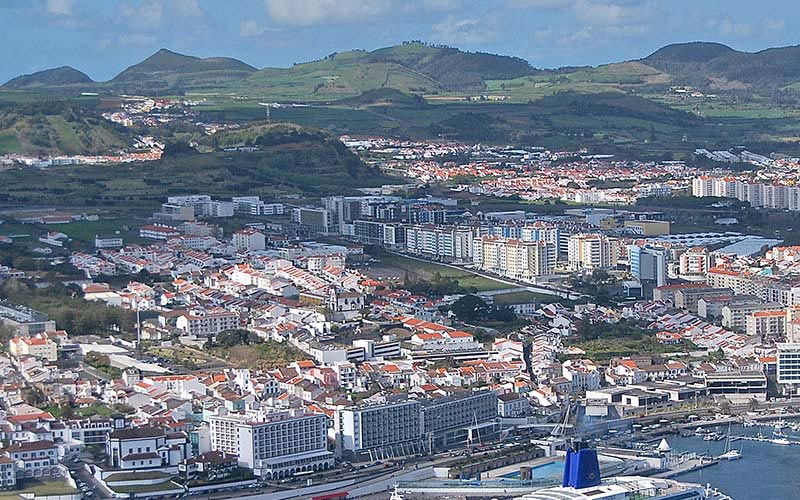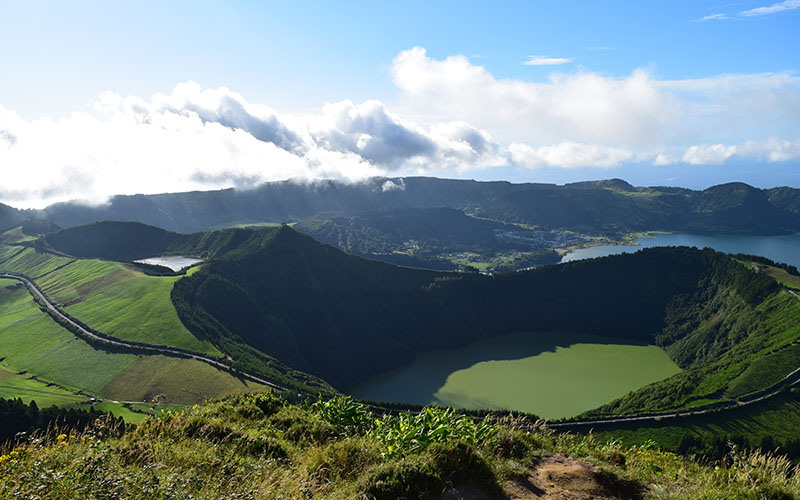Explore São Miguel Island in the Azores, a gem most travelers overlook. Sao Miguel, an isolated island in the Atlantic, resembles Plato’s Atlantis. It is Portugal’s largest and biggest island, and visiting it is one of the best things to do in Portugal. São Miguel has underground caverns, volcanic craters, thermal hot springs, and meandering hiking trails.
An island in the Azores that can be driven over in four hours holds so much. São Miguel Island’s weather and beauty are accessible to solitary, couple, or family travelers seeking the Azores’ distinctive and dramatic nature.
How to Travel to São Miguel? Ponta Delgada Airport (PDL) is the largest airport in the Azores, located on São Miguel, Lisbon, Porto, and London have direct flights from Europe. Lisbon is a 2.5-hour flight.
Driving in São Miguel: Owning a car allows you to go between São Miguel’s scarce destinations in the Azores. The islands’ public transit is unreliable. A self-driven car helps you zip and zap through the most exclusive spots at your own pace.
Each island has car rentals so that you can explore. It is preferable to book a car for São Miguel in advance, as there is a limited number, especially during peak season.
Which Azores Island is best? São Miguel Island destinations consist of nine islands
Three groups describe them:
- Eastern Group: Sao Miguel and Santa Maria
- Central Group: Graciosa, Sao Jorge, Faial, Pico, and Terceira
- Western Group: Corvo and Flores
We suggest spending a week exploring São Miguel’s hidden gem, the central island. Adjust the São Miguel itinerary to your interests and vacation time, or follow it discreetly. Also, keep in mind the unpredictability of the weather in São Miguel.
Day 1: Ponta Delgada, São Miguel’s Capital city

Irrespective of your seat on the plane, peeking out the window to see lush island vistas will boost your excitement. São Miguel is the largest Azorean Island and one of the best places to visit in Portugal. In the Azores, the biggest does not mean the busiest; SãoMiguel still has the archipelago’s laid-back feel.
Ponta Delgada, on São Miguel, is the Azores’ capital – and probably the only urban city in the Azores. The Historical Quarter made Ponta Delgada a vital trading port in the 18th and 19th centuries. Avenida Infante Dom Henrique along the waterfront offers spectacular views of the sea and city in any season. The Portuguese army still uses the 16th-century Forte de Sao Brás. Fort hosts the Azores Military Museum.
Convento de Nossa Senhora da Esperança has stood since 1535. The church’s exterior is a humble colonial architecture with dark green shutters. The church’s altar is gold, and the arching roof has Baroque embellishments. António de Oliveira Bernardes’ glazed tile panels make it a place of worship and beauty. Don’t miss climbing the Bell Tower at Praca do Municipio – when it’s not busy.
Day 2: Sao Miguel’s western coast

From Ponta Delgada, drive west for 25 minutes to reach Canary Lagoon. Sete Cidades is what draws tourists to Sao Miguel. Starting here, you will see stunning viewpoints and amazing volcanic lakes. Ride a bicycle and explore the unbelievable natural beauty of craters tucked between lakes. You will want to arrange clear skies on this day because you’ll be high up for the vistas.
The terrain and path are accessible, so you will not be exhausted by the finish. Find the Boca do Inferno stairs from the Canary Lagoon parking lot. Miradouro da Boca do Inferno is the first 360-degree viewpoint. From this location, you can see the emerald-green waters of Santiago Lake and Azul Lake. Both appear like magnificent stones cut from crater landscapes. This is the Azores’ renowned vista. You will also get the chance to take a dip in the pool – which is naturally heated by volcanic actions.
Day 3: Fogo Lake, São Miguel’s heart

The EN1-1A highway loops around São Miguel, Praia do Areal de Santa Bárbara is 38.5 km from Mosteiros. This is one of the Azores’ most gorgeous beaches. Black sand, lifeguards, a surf school, and a cafe are available. Surfers favor this side as waves support good surfing conditions.
Salto do Cabrito waterfall is inland from the beach. A hydroelectric plant has a trail. A peaceful walk leads to a flowing waterfall between rocks. If it is hot, swim at the bottom of the falls. You will feel at one with the Azores’ natural beauty. The highlight of this day is one of the best hiking places in São Miguel, Lagoa do Fogo. It is a gorgeous and highly elevated crater lake. Your eyes will rejuvenate watching the burst of beauty and colors.
Day 4: Southern Coast of São Miguel, Furnas

Furnas, one of the major communities in the Azores, is located in the south of Sao Miguel, as is the Furnas Valley. What is this area’s best feature? This little town is inside the volcanic crater. One of the Azores’ natural features is the volcanic activity, and São Miguel’s Furnas Valley is the epicenter. But fear not, the volcanic eruption was last encountered in 1630.
You can spend the entire day in Sao Miguel’s valley without having a moment to spare in boredom. This area is a hub for geothermal activity, from mineral springs and thermal pools to the odd egg odor around the geysers. Furnas Lake, created from a crater, has water below the tops of its surrounding mountains. Furnas Lake’s lush rim with trails and walks is perfect for hiking on São Miguel. Nossa Senhora das Vitórias Chapel, built in 1882, is at the lake’s shore. It seems abandoned, with age stains, which is not surprising considering it is no longer used. Plus, the locals use geothermal heat to cook delicious food like stew, pastries, and meat. Other places to see around in São Miguel’s Furnas is Caldeiras das Furnas, Terra Nostra Gardens, and Terra Nostra Gardens.
Day 5: São Miguel’s east and north coasts

São Miguel’s east side is loaded with tumbling waterfalls along the ocean. Salto do Prego is less crowded in the morning. The 7.6-kilometer circular walk to the waterfall is popular. Since it is a tiny path, it is lovely to have more space for yourself than sluggish walkers. You will reach the Salto do Prego waterfall through orchards and wooden bridges.
On your journey back, you will pass by Sanguinho, an abandoned but now-restored village. Walking through it, you will get a peek at the locals’ tranquil, secluded lives. Continue your trek to Ponta do Sossego viewpoint to soothe your senses with birds chirping and colorful foliage around. After a few minutes’ drive, tick off Ribeira dos Caldeirões Natural Park and Boats Viewpoint.
Conclusion
São Miguel is like the spring season – filled with colorful attractions and ripe with natural landmarks. You can go from driving through winding roads to putting your leg up by a volcanic lake. This go-to itinerary hopefully helps you plan a wonderful getaway. You deserve this much-needed break. Moreover, the beauty of São Miguel is such that it is one of the places you must visit in Europe on your Schengen visa.
